HONDA PRELUDE 2000 Owner's Manual (in English)
Manufacturer: HONDA, Model Year: 2000, Model line: PRELUDE, Model: HONDA PRELUDE 2000Pages: 293, PDF Size: 3.43 MB
Page 151 of 293

Automati
c Transmissio n
When you accelerate away from a
stop, the transmission will be in first
gear. The transmission will not
automatically upshift. Watch the
tachometer and upshift manually
before the engine reaches redline.
The transmission remains in the
selected gear (4, 3, 2, or 1). There is
no automatic downshift when you
push the accelerator pedal to the
floor.
The transmission may automatically downshift from fourth gear to third"
gear under the following conditions: The car speeds drops below
20 mph (32 km/h).
If you drive uphill between
20 — 31 mph (32 — 50 km/h).
If you press the brake pedal as you
drive downhill.
Downshifting gives you more power
when climbing or provides engine
braking when going down a steep hill.
The transmission will also shift automatically as the car comes to a
complete stop. It will downshift to
first gear when the car speed is under 6 mph (10 km/h).
If you try to manually downshift at aspeed that would cause the engine to
exceed the redline in a lower gear,
the transmission will not downshift.
If you try to downshift from fourth
gear to third gear, the gear indicator
will flash /3/ several times, then
return to /4/; if yo
u try to downshift
from third gear to second gear, the
gear indicator will flash /2/ several
times, then return to third gear.
Drivin g
Page 152 of 293
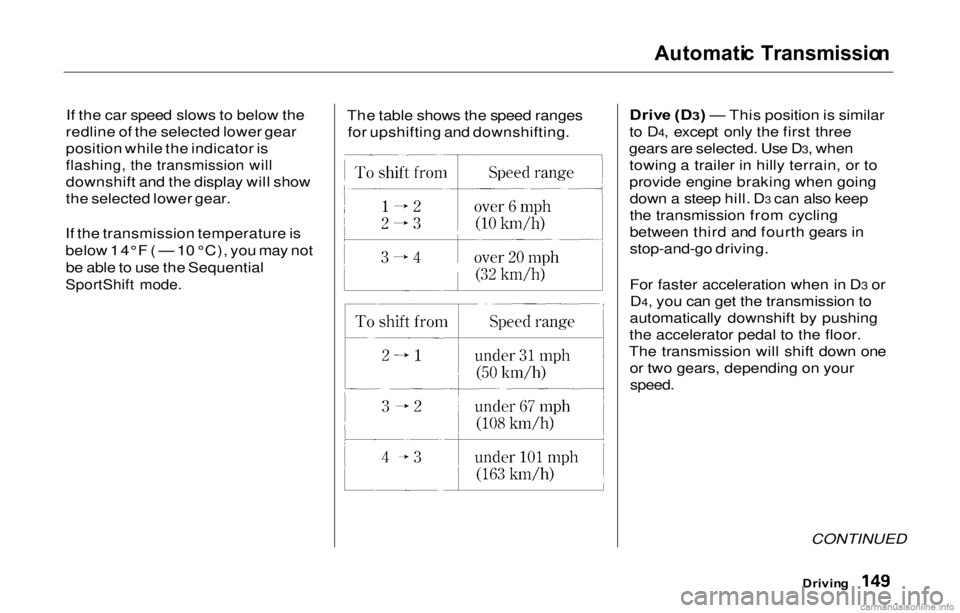
Automati
c Transmissio n
If the car speed slows to below the
redline of the selected lower gear
position while the indicator is
flashing, the transmission will
downshift and the display will show
the selected lower gear.
If the transmission temperature is
below 14°F ( — 10 °C), you may not be able to use the Sequential
SportShift mode.
The table shows the speed ranges
for upshifting and downshifting. Driv
e (D3) — This position is similar
to D4, except only
the first three
gears are selected. Use D3, when towing a trailer in hilly terrain, or to
provide engine braking when goingdown a steep hill. D3 can also keep
the transmission
from cycling
between
third and fourth gears in
stop-and-go driving.
For faster acceleration when in D3 or D4, you can get the transmission to
automatically downshift by pushing
the accelerator pedal to the floor.
The transmission will shift down one or two gears, depending on your
speed.
CONTINUED
Drivin g
Page 153 of 293

Automati
c Transmissio n
Secon d (2 ) — This position locks
the transmission in second gear. It does not downshift to first gear
when you come to a stop. Second gives you more power when climbing,
and increased engine braking when
going down steep hills, Use second
gear when starting out on a slippery surface or in deep snow. It will help
reduce wheelspin. Firs
t (1 ) — With the lever in this
position, the transmission locks in
First gear.
If you shift into First position when
the car speed exceeds 31 mph (50
km/h), the transmission shifts into Second gear first to avoid the
application of the sudden engine
brake. Engin
e Spee d Limite r
If you exceed the maximum speed
for the gear you are in, the engine speed will enter into the tachometer's
red zone. If this occurs, you may feel
the engine cut in and out. This is caused by a limiter in the engine's
computer controls. The engine will
run normally when you reduce the
RPM below the red zone.
Drivin g
Page 154 of 293
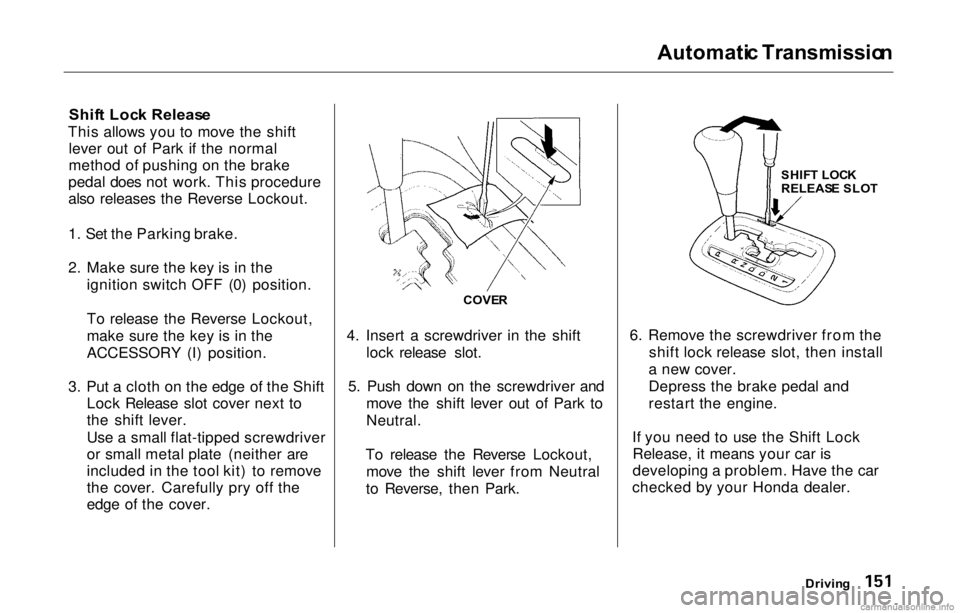
Automati
c Transmissio n
Shif t Loc k Releas e
This allows you to move the shift lever out of Park if the normal
method of pushing on the brake
pedal does not work. This procedure
also releases the Reverse Lockout.
1. Set the Parking brake.
2. Make sure the key is in the
ignition switch OFF (0) position.
To release the Reverse Lockout,
make sure the key is in the
ACCESSORY (I) position.
3. Put a cloth on the edge of the Shift Lock Release slot cover next to
the shift lever.
Use a small flat-tipped screwdriver
or small metal plate (neither are
included in the tool kit) to remove
the cover. Carefully pry off the
edge of the cover. 4. Insert a screwdriver in the shift
lock release slot.
5. Push down on the screwdriver and move the shift lever out of Park to
Neutral.
To release the Reverse Lockout, move the shift lever from Neutral
to Reverse, then Park. 6. Remove the screwdriver from the
shift lock release slot, then install
a new cover.
Depress the brake pedal and
restart the engine.
If you need to use the Shift Lock Release, it means your car is
developing a problem. Have the car
checked by your Honda dealer.
Driving
SHIF
T LOC K
RELEAS E SLO T
COVE R
Page 155 of 293

Parkin
g
Always use the parking brake when you park your car. The indicator onthe instrument panel shows that the
parking brake is not fully released; itdoes not indicate that the parking
brake is firmly set. Make sure the
parking brake is set firmly or your car may roll if it is parked on an
incline.
If your car has an automatic
transmission, set the parking brake
before you put the transmission in Park. This keeps the car from
moving and putting pressure on the
parking mechanism in the
transmission — making it easier to
move the shift lever out of Park
when you want to drive away. If the car is facing uphill, turn the
front wheels away from the curb. If
you have a manual transmission, put it in first gear.
If the car is facing downhill, turn the
front wheels toward the curb. If you
have a manual transmission, put it in reverse gear.
Make sure the parking brake is fully
released before driving away.
Driving with the parking brake
partially set can overheat or damage
the rear brakes. Parkin
g Tip s
• Make sure the moonroof and the windows are closed.
Turn off the lights. Place any packages, valuables, etc.,
in the trunk or take them with you.
Lock the doors with the key or the
remote transmitter. Never park over dry leaves, tall
grass, or other flammable materials. The three way catalytic
converter gets very hot, and could
cause these materials to catch on
fire.
Drivin g
Page 156 of 293

Th
e Brakin g Syste m
Your Honda is equipped with disc brakes at all four wheels. A powerassist helps reduce the effort needed
on the brake pedal. The ABS helps
you retain steering control when
braking very hard.
Put your foot on the brake pedal only
when you intend to brake. Resting
your foot on the pedal keeps the
brakes applied lightly, causing them
to build up heat. Heat build-up can
reduce how well your brakes work. It also keeps your brake lights on all
the time, confusing drivers behind
you.
Constant application of the brakes
when going down a long hill builds up heat and reduces their effective-
ness. Use the engine to assist the
brakes by downshifting to a lower
gear and taking your foot off the accelerator pedal.
Check your brakes after driving
through deep water. Apply the
brakes moderately to see if they feel normal. If not, apply them gently and
frequently until they do. Since a
longer distance is needed to stop
with wet brakes, be extra cautious and alert in your driving. Brak
e Wea r Indicator s
All four brakes have audible brake wear indicators.
When the brake pads need replacing,
you will hear a distinctive metallic "screeching" sound when you apply
the brakes. If you do not have the
brake pads replaced, they will begin screeching all the time.
Your brakes may sometimes squeal or squeak when you apply them
lightly. Do not confuse this with the
brake wear indicators. They make a
very audible "screeching."
Driving
Page 157 of 293
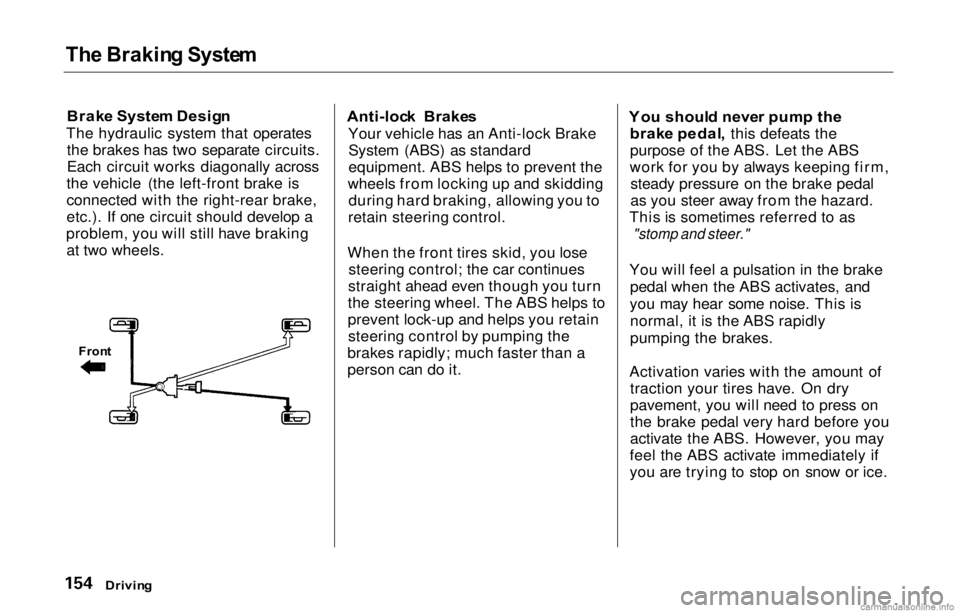
Th
e Brakin g Syste m
Brak e Syste m Desig n
The hydraulic system that operates the brakes has two separate circuits.
Each circuit works diagonally across
the vehicle (the left-front brake is
connected with the right-rear brake,
etc.). If one circuit should develop a
problem, you will still have braking at two wheels. Anti-loc
k Brake s
Your vehicle has an Anti-lock Brake System (ABS) as standard
equipment. ABS helps to prevent the
wheels from locking up and skidding during hard braking, allowing you to
retain steering control.
When the front tires skid, you lose steering control; the car continues
straight ahead even though you turn
the steering wheel. The ABS helps to
prevent lock-up and helps you retain steering control by pumping the
brakes rapidly; much faster than a
person can do it. Yo
u shoul d neve r pum p th e
brak e pedal , this defeats the
purpose of the ABS. Let the ABS
work for you by always keeping firm, steady pressure on the brake pedal
as you steer away from the hazard.
This is sometimes referred to as
"stomp and steer."
You will feel a pulsation in the brake pedal when the ABS activates, and
you may hear some noise. This is normal, it is the ABS rapidly
pumping the brakes.
Activation varies with the amount of traction your tires have. On dry
pavement, you will need to press on
the brake pedal very hard before you
activate the ABS. However, you may
feel the ABS activate immediately if
you are trying to stop on snow or ice.
Drivin g
Fron
t
Page 158 of 293

Th
e Brakin g Syste m
Important Safety Reminders
AB S doe s no t reduc e th e tim e o r
distanc e i t take s t o sto p th e car , it
only helps with steering control
during braking. You should always
maintain a safe following distance
from other vehicles. AB
S wil l no t preven t a ski d tha t
result s fro m changin g directio n
abruptly , such as trying to take a
corner too fast or making a sudden
lane change. Always drive at a safe,
prudent speed for the road and
weather conditions.
AB S canno t preven t a los s o f
stability . Always steer moderately
when you are braking hard. Severe or sharp steering wheel movement
can still cause your car to veer into
oncoming traffic or off the road. A
vehicl e wit h AB S ma y requir e a
longe r distanc e t o sto p on loose or
uneven surfaces, such as gravel or snow, than a vehicle without anti-
lock. Slow down and allow a greater distance between vehicles under
those conditions.
CONTINUED
Drivin g
Page 159 of 293
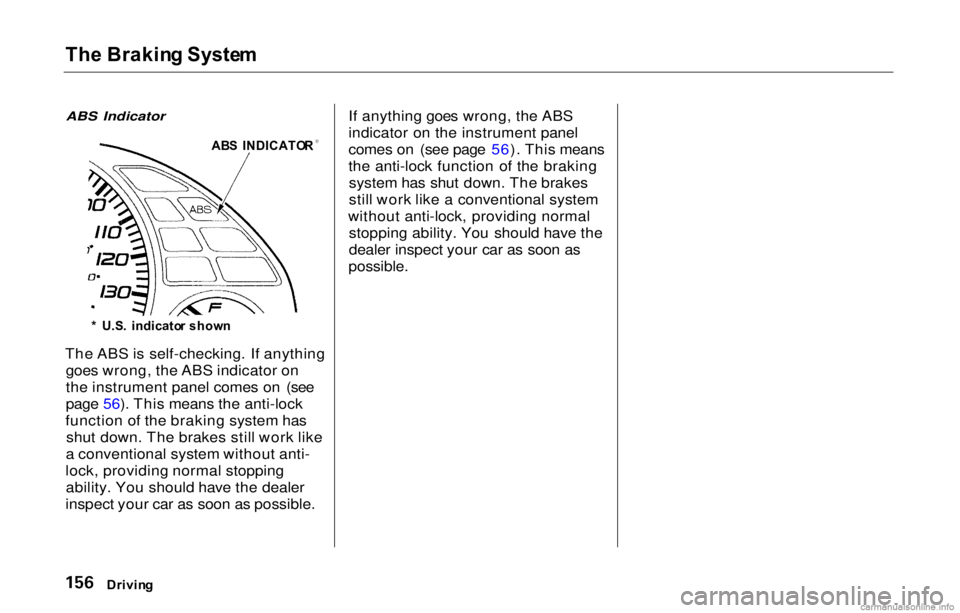
Th
e Brakin g Syste m
ABS Indicator
The ABS is self-checking. If anything goes wrong, the ABS indicator on
the instrument panel comes on (see
page 56). This means the anti-lock
function of the braking system has shut down. The brakes still work like
a conventional system without anti-
lock, providing normal stopping ability. You should have the dealer
inspect your car as soon as possible. If anything goes wrong, the ABS
indicator on the instrument panel
comes on (see page 56). This means
the anti-lock function of the braking
system has shut down. The brakes
still work like a conventional system
without anti-lock, providing normal stopping ability. You should have the
dealer inspect your car as soon as
possible.
Drivin g
*
U.S . indicato r show n
AB
S INDICATO R
Page 160 of 293
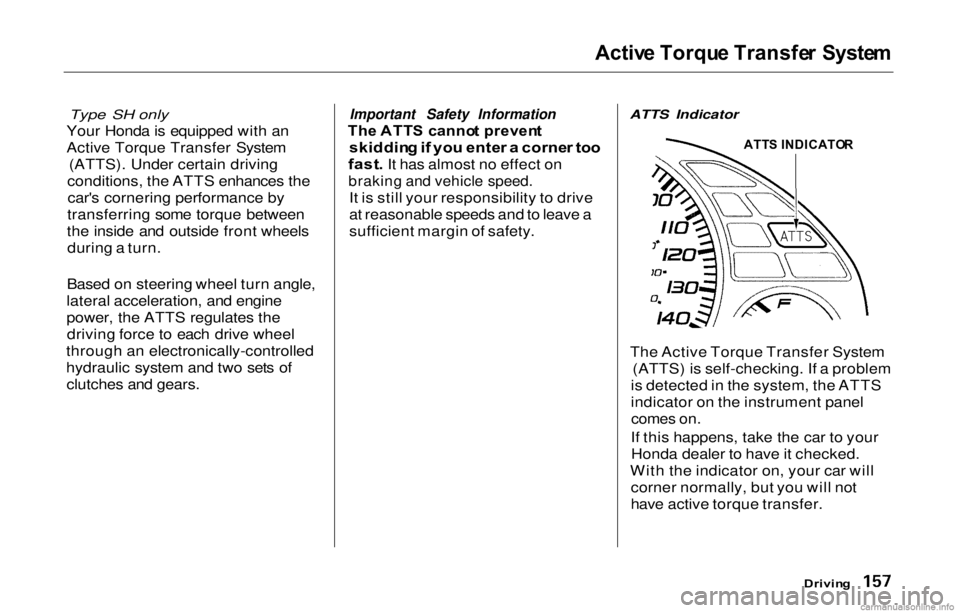
Activ
e Torqu e Transfe r Syste m
Type SH only
Your Honda is equipped wit
h an
Active Torque Transfer System (ATTS). Under certain driving
conditions, the ATTS enhances the car's cornering performance by
transferring some torque between
the inside and outside front wheels during a turn.
Based on steering wheel turn angle,
lateral acceleration, and engine
power, the ATTS regulates the driving force to each drive wheel
through an electronically-controlled
hydraulic system and two sets of clutches and gears.
Important Safety Information
Th e ATT S canno t preven t
skiddin g if yo u ente r a corne r to o
fast . It has almost no effect on
braking and vehicle speed.
It is still your responsibility to drive
at reasonable speeds and to leave a
sufficient margin of safety.
ATTS Indicator
The Active Torque Transfer System (ATTS) is self-checking. If a problem
is detected in the system, the ATTS
indicator on the instrument panel
comes on.
If this happens, take the car to your Honda dealer to have it checked.
With the indicator on, your car will corner normally, but you will not
have active torque transfer.
Driving
ATT
S INDICATO R